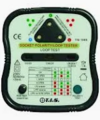'course it's also possible there is a brown to CPC fault and this botch stopped the MCB tripping.
This should be soon apparent when corrected, however as far as testing goes, the problem is the cost of the meter to test it. These meters


are the cheapest I could find, blue one £35 and tests installation only, red one £70 and also tests the loop impedance and RCD as well, however having them does not mean you can use them.
With the switched FCU turned off, testing both lives (Line and Neutral) to earth with a cheap meter on the ohms range will only show a direct short, and even a plug in tester with loop,

will not likely show a neutral to earth fault. The problem is neutral is outside ones house connected to earth, so only way to test is with the circuit isolated, a MCB does not isolate it only turns off the line, a RCBO also normally does not isolate although some do, so the switch on the FCU or the RCD, or isolator needs turning off to test neutral to earth.
And water will often connect a wire to earth enough to trip a RCD but not enough to detect with a meter using 9 volt, the meters shown use 500 volt.
So if swapping the cables correct way around works without tripping anything then all seems good. But if it trips then likely neutral has an earth fault, which needs correcting, as it can cause what seems random tripping of the RCD. So may as well swap to correct colours, but both line and neutral are classed as live, so colours being swapped was not really a problem. It just raises the question why?




